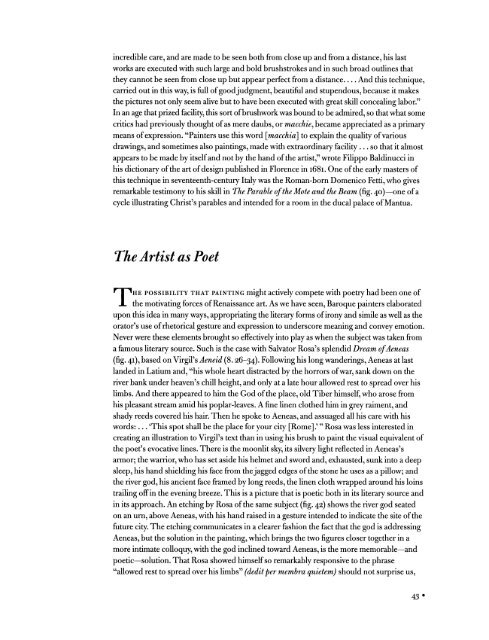GOING FOR BAROQUE Into the Bin - The Metropolitan Museum of Art
GOING FOR BAROQUE Into the Bin - The Metropolitan Museum of Art
GOING FOR BAROQUE Into the Bin - The Metropolitan Museum of Art
You also want an ePaper? Increase the reach of your titles
YUMPU automatically turns print PDFs into web optimized ePapers that Google loves.
incredible care, and are made to be seen both from close up and from a distance, his last<br />
works are executed with such<br />
large<br />
and bold brushstrokes and in such broad outlines that<br />
<strong>the</strong>y cannot be seen from close up but appear perfect<br />
from a distance_And this technique,<br />
carried out in this way, is full <strong>of</strong> good judgment,<br />
beautiful and<br />
stupendous,<br />
because it makes<br />
<strong>the</strong> pictures<br />
not seem<br />
only<br />
alive but to have been executed with great skill concealing<br />
labor."<br />
In an age that prized facility,<br />
this sort <strong>of</strong> brushwork was bound to be admired,<br />
so that what some<br />
critics had previously thought<br />
<strong>of</strong> as mere<br />
daubs,<br />
or macchie, became<br />
as<br />
appreciated<br />
a primary<br />
means <strong>of</strong> expression.<br />
"Painters use this word<br />
[macchia]<br />
to explain<br />
<strong>the</strong> quality<br />
<strong>of</strong> various<br />
drawings,<br />
and sometimes also paintings,<br />
made with<br />
so<br />
extraordinary facility...<br />
that it almost<br />
appears to be made<br />
by<br />
itself and not by<br />
<strong>the</strong> hand <strong>of</strong> <strong>the</strong> artist," wrote<br />
Filippo<br />
Baldinucci in<br />
his dictionary<br />
<strong>of</strong> <strong>the</strong> art <strong>of</strong> design published<br />
in Florence in 1681. One <strong>of</strong> <strong>the</strong> early<br />
masters <strong>of</strong><br />
this technique<br />
in was seventeenth-century Italy<br />
<strong>the</strong> Roman-born Domenico Fetti, who gives<br />
remarkable<br />
testimony<br />
to his skill in <strong>The</strong> Parable<br />
<strong>of</strong> <strong>the</strong> Mote and <strong>the</strong> Beam (fig. 40)?one<br />
<strong>of</strong> a<br />
cycle illustrating<br />
Christ's parables and intended for a room in <strong>the</strong> ducal palace <strong>of</strong> Mantua.<br />
<strong>The</strong> <strong>Art</strong>ist as Poet<br />
possibility that painting<br />
might actively compete with poetry had been one <strong>of</strong><br />
<strong>The</strong><br />
<strong>the</strong> motivating<br />
forces <strong>of</strong> Renaissance art. As we have seen, Baroque painters<br />
elaborated<br />
upon this idea in many ways, appropriating<br />
<strong>the</strong> literary<br />
forms <strong>of</strong> irony<br />
and simile as well as <strong>the</strong><br />
orator's use <strong>of</strong> rhetorical gesture and expression<br />
to underscore<br />
meaning<br />
and convey emotion.<br />
Never were <strong>the</strong>se elements<br />
so<br />
brought effectively<br />
into as play<br />
when <strong>the</strong> was subject<br />
taken from<br />
a famous<br />
source.<br />
literary<br />
Such is <strong>the</strong> case with Salvator Rosa's<br />
splendid<br />
Dream<br />
<strong>of</strong> Aeneas<br />
(fig. 41), based on Virgil's<br />
Aeneid<br />
(8.26-34). Following<br />
his<br />
long wanderings,<br />
Aeneas at last<br />
landed in Latium and, "his whole heart distracted by<br />
<strong>the</strong> horrors <strong>of</strong> war, sank down on <strong>the</strong><br />
river bank under heaven's chill height,<br />
and at a only<br />
late hour allowed rest to spread<br />
over his<br />
limbs. And <strong>the</strong>re appeared<br />
to him <strong>the</strong> God <strong>of</strong> <strong>the</strong> place,<br />
old Tiber himself, who arose from<br />
his pleasant<br />
stream amid his poplar-leaves.<br />
A fine linen clo<strong>the</strong>d him in grey raiment, and<br />
shady<br />
reeds covered his hair. <strong>The</strong>n he<br />
spoke<br />
to Aeneas, and assuaged<br />
all his care with his<br />
"<br />
words:... 'This spot shall be <strong>the</strong> place for your city [Rome].' Rosa was less interested in<br />
an<br />
creating<br />
illustration to Virgil's<br />
text than in using<br />
his brush to paint<br />
<strong>the</strong> visual<br />
equivalent <strong>of</strong><br />
<strong>the</strong> poet's evocative lines. <strong>The</strong>re is <strong>the</strong> moonlit<br />
sky, its silvery light reflected in Aeneas's<br />
armor; <strong>the</strong> warrior, who has set aside his helmet and sword and, exhausted, sunk into a deep<br />
sleep,<br />
his hand<br />
shielding<br />
his face from <strong>the</strong> jagged edges<br />
<strong>of</strong> <strong>the</strong> stone he uses as a pillow;<br />
and<br />
<strong>the</strong> river god,<br />
his ancient face framed<br />
by long reeds, <strong>the</strong> linen cloth wrapped around his loins<br />
trailing<br />
<strong>of</strong>f in <strong>the</strong> evening<br />
breeze. This is a picture<br />
that is poetic both in its source literary<br />
and<br />
in its approach.<br />
An<br />
etching by Rosa <strong>of</strong> <strong>the</strong> same subject (fig. 42)<br />
shows <strong>the</strong> river god<br />
seated<br />
on an urn, above Aeneas, with his hand raised in a gesture intended to indicate <strong>the</strong> site <strong>of</strong> <strong>the</strong><br />
future<br />
city. <strong>The</strong> etching<br />
communicates in a clearer fashion <strong>the</strong> fact that <strong>the</strong> god<br />
is addressing<br />
Aeneas, but <strong>the</strong> solution in <strong>the</strong> painting,<br />
which<br />
brings<br />
<strong>the</strong> two figures<br />
closer<br />
toge<strong>the</strong>r<br />
in a<br />
more intimate<br />
colloquy,<br />
with <strong>the</strong> god<br />
inclined toward Aeneas, is <strong>the</strong> more memorable?and<br />
poetic?solution. That Rosa showed himself so remarkably responsive<br />
to <strong>the</strong> phrase<br />
"allowed rest to over spread<br />
his limbs"<br />
(deditper<br />
membra<br />
quietem)<br />
should not<br />
surprise us,<br />
A3
















